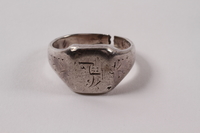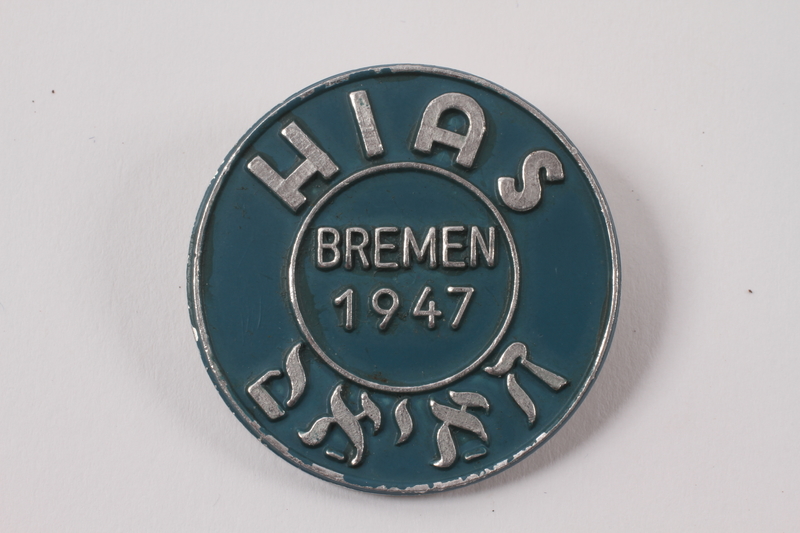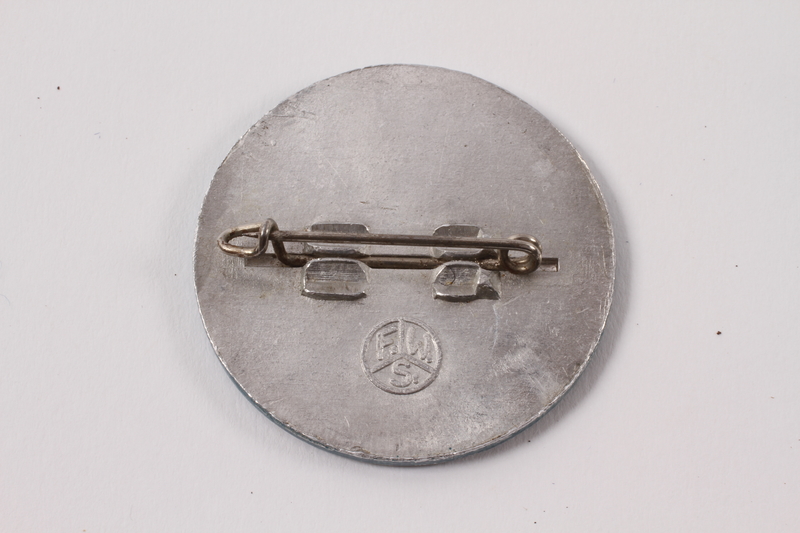Overview
- Brief Narrative
- HIAS badge worn by 19 year old Isaak Racs (later Jack Ratz) during his October 1947 journey from Bremen to the United States. On July 1, 1941, Germany invaded Latvia. That summer, Isaak was forced into the Riga ghetto with his parents, Moses and Tema, and three younger brothers, Rafael, Chona, and Aron. On December 8, his mother and brothers were executed during the liquidation of the ghetto. Isaak and his father were forced laborers in the small ghetto, until they were sent to Lenta labor camp in 1943. Around August 1944, Isaak and Moses were sent to Stutthof concentration camp. In October, they were transferred to Burggraben and worked for the Schichau-Werft shipyard in Danzig. In December 1944 or early 1945, they were sent on a forced march to Goddentow. On March 9, 1945, the prisoners were ordered on another march, but Isaak and Moses escaped into the woods. They were liberated by Soviet forces on March 10. They then lived in Landsberg displaced persons camp. Isaak emigrated to the US in 1947. Moses joined him in 1949.
- Date
-
use:
1947 October-1947 November
- Geography
-
received:
Bremen (Germany)
- Credit Line
- United States Holocaust Memorial Museum Collection, Gift of Jack Ratz
- Markings
- front, embossed : HIAS / BREMEN / 1947 / חאיאם
back, embossed, maker’s mark : F. / W. / S. - Contributor
-
Subject:
Jack Ratz
Issuer: Hebrew Immigrant Aid Society (HIAS)
- Biography
-
Isaak Racs was born on December 26, 1927, in Riga, Latvia, to Moses and Tema Schusterman Racs. He had four brothers: Mendel, born on December 26, 1923, Rafael Eliezer, born on February 28, 1928, Chona Reuven, born on August 13, 1931, and Aron David, born in 1940. His mother Tema was born in 1900 in Riga to Aron David and Chana Riva Schusterman. She had one brother, three half-brothers, and two half-sisters. Isaak’s father Moses was born on May 8, 1900. He had four brothers and three sisters. Moses was a tailor and had a shop in their apartment. Isaak attended a Jewish school, where he learned Hebrew. He spoke Yiddish at home with his family and learned Latvian and Russian. He was unable to afford to attend high school and worked in a shipping company office.
On June 17, 1940, the Soviet Union annexed Latvia and ran protesters over with tanks. Under Soviet rule, Isaak was allowed to go to school at night and work in the day. The Soviets began deporting the wealthy, Jews and non-Jews, to Siberia and Isaak’s boss and his wife were taken overnight. Isaak secretly celebrated his bar mitzvah by going to shul and having a small party with his family. Isaak’s older brother Mendel, age 17, was conscripted into the Soviet army. On July 1, 1941, Germany invaded Latvia. On July 4, the Germans grabbed Jewish men off the street and forced them to light the synagogues on fire with people inside. Mendel did not come home. Isaak searched for him for several days, in town and in the German prison camp for Soviet soldiers, but never found him. On August 1, the Jews were required to wear Star of David badges. In late summer, Isaak and his family moved into the newly established ghetto, which was sealed on October 25. Isaak was permitted to leave the ghetto for his job in the lumberyard. He later worked with his father Moses, who was a tailor for the police department. On November 28, the Germans ordered that all able bodied men older than 16 report to the assembly area. Although Isaak was only 14, he insisted that he could work as well as an adult and went with his father and his cousin, Motel Max Kit. They were sent to a sectioned off area of the ghetto called the small ghetto. On November 30, the Germans took 11,000 ghetto residents to Rumbula forest and shot them. A few days later, Isaak saw one of his brothers through the fence and knew his family was still alive. On December 8, the Germans took Isaak’s mother, Tema, and brothers, Rafael, Chona, and Aron, in a group of over 14,000 people to Rumbula and executed them. Isaak and other young men were forced to return to the ghetto to bury the bodies of Jews who had been shot after the mass executions. Between December 1941 and spring 1942, the Germans brought in thousands of German, Austrian and Czechoslovakian Jews to fill the ghetto. In 1942, a jeweler in the small ghetto offered to make commemorative items for those who lost family members. Isaak brought him a spoon which was made into an engraved ring to honor his family. He worked in the small ghetto carrying heavy water pipes. Isaak later was sent to work in a factory that produced food for the German army. He was made foreman of a group of 20 Jews. One of the other inmates was related to a German official and was able to get Isaak’s father Moses brought to the factory. Moses had been working in the swamps, collecting plant material that was burned as fuel, which was dangerous work.
In 1943, the small ghetto was liquidated and Isaak and Moses were sent to Lenta labor camp. Isaak was assigned prisoner number 281. The factory produced clothing for the German army and Moses worked as a tailor. Isaak worked in the kitchen, cleaning kettles. He was able to get extra food to share with Moses and melted animal fat onto bread for additional nourishment. Isaak was questioned by a SS commander about taking extra food, but another inmate saved him. One night they were forced to get up and their heads were shaved. They were afraid they would be killed, but were marched to Salaspils, a work education camp in Riga, a few days later. There were no barracks and they had to sleep outside. After a month, they returned to Lenta. In approximately August 1944, they were put on a ship and taken to Danzig, Germany (Gdansk, Poland). They were put on barges and sent to Stutthof concentration camp. Upon arrival, they were given striped uniforms and wooden shoes. Isaak was assigned prisoner number 93292 and Moses number 93293. Isaak found his cousin Motel in the camp. They were put in a severely overcrowded barrack and had to sleep 3 or 4 men to a bed. There were no proper sanitary facilities and it was very cold. The kapos were ordered to kill Jews and beat them to death. Isaak was assigned to push wagons full of hair, clothing, glasses, and shoes from murdered Jews. They were given very little food. Moses had a hernia belt with diamonds and gold sewn inside. He traded some gold for bread and gave Isaak the remaining gold and diamonds in a pouch. Overnight, one of Isaak’s bunkmates stole the pouch. Isaak offered to barter his silver ring for food but it was never taken. People were being sent away to work in other camps. They heard that the next transport was for mechanics and agreed to pretend to be mechanics so they would be chosen. Shortly after, some prisoners attempted to escape and were caught. Isaak and the other prisoners were forced to watch them be hanged.
In October, Isaak, Moses, and Motel were sent to Burggraben, Germany. They worked for the Schichau-Werft shipyard in Danzig. Isaak worked the 12 hour night shift. He got very little sleep because he still had to work at the camp in the daytime and it took 3 hours to get to the shipyard. The Russian air force bombed Danzig and the Burggraben prisoners could no longer go to the shipyard because the train tracks were hit. Isaak was sent with a labor group to remove ice and snow from the tracks and to put damaged trains back on the tracks. The trains were loaded with cigarettes and Isaak stole 100 packs. The whole group was interrogated about smuggling cigarettes. Isaak admitted to taking 2 packs and was beaten. He and Moses still had several dozen hidden packs. In December 1944 or early 1945, Isaak, Moses, and Motel were sent on a forced march for several days to Goddentow (Godetowo, Poland). The barracks had wooden shelves instead of beds. Isaak worked in the kitchen, cutting wood and hauling potatoes. Isaak traded some cigarettes for food and found horse meat to share with Moses and Motel. He began stealing extra potatoes to share, and was caught and whipped. On March 9, they were ordered to march again. Moses insisted that he could not carry on, so they hid in the woods. On March 10, they were liberated by Soviet troops.
Isaak and Moses stayed in Lauenberg, Germany. Isaak was hospitalized with typhus until April or May, then worked as a guard at the hospital. After several months, Isaak decided that they had to escape from the Soviets. For two months, Isaak and Moses traveled through Łódź, Katowice, Krakow, Bratislava, Linz, and Vienna. They received false paperwork in Vienna stating they were German Jews and went to Munich. During their journey, Moses met Dora Glikson Graubart, a survivor from Warsaw. Moses and Dora married in Munich on July 5, 1946. Moses found a job as a tailor and settled in Munich. Isaak moved to Landsberg displaced persons camp to pursue educational opportunities. In August 1946, he completed a radio mechanic course through ORT. He continued his education in Munich and got an engineering degree. Isaak and Moses learned that their entire extended family had perished in the Holocaust. Isaak sailed from Bremen on the SS Marine Flasher on October 29, 1947, arriving in New York on November 10. He changed his last name to Ratz and adopted the first name Jack. He settled in Brooklyn and repaired televisions. Jack’s father and stepmother arrived on May 29, 1949. On June 4, 1950, Jack married Doris Wittenberg (1928-2006). They had three children. During a trip to Israel, Isaak learned that his brother Mendel had been killed in 1942 near Leningrad. Jack’s father Moses, age 82, died on December 8, 1982. Jack published a book about his experiences and tells his story to schools and synagogues.
HIAS, the Hebrew Immigrant Aid Society, was founded in the 1881 in the Lower East Side of New York City. Their original mission was to rescue Jews in Eastern Europe and Russia who were being persecuted and murdered in pogroms. They provided the recent refugees with meals and shelter, and helped them find jobs. In 1904, HIAS set up an office on Ellis Island and expanded their aid services to new arrivals, guiding them through the immigration process, preventing deportations, and searching for relatives. The organization expanded during the interwar years to ensure that Jewish refugees could find welcome and safety in their new countries. HIAS helped form HICEM, a joint bureau of three aid agencies established in Paris to centralize eastern European immigration. By the 1930s, the American Jewish Joint Distribution Committee (AJDC) provided most of the money and HIAS provided the majority of the staff members. After the occupation of France by Nazi Germany in June 1940, the office moved to Marseille and an office was opened in Lisbon, Portugal. HIAS continued to assist refugees in America during World War II (1939-1945), but the restrictive immigration policies of the US government severely limited new arrivals. After the war ended in May 1945, HIAS was instrumental in the resettlement of hundreds of thousands of displaced persons to communities in the US and around the world. In this century, their mission was expanded to aid non-Jewish persons. HIAS continues to work on the front lines, assisting refugees no matter where they are.
Physical Details
- Classification
-
Identifying Artifacts
- Category
-
Badges
- Object Type
-
Buttons (information artifacts) (aat)
- Physical Description
- Circular, silver colored metal pin with raised silver text on a blue painted field: HIAS in the top border, and in Hebrew below, around a raised circle with BREMEN 1947. On the back is a C clasp with straight pin and a maker's mark.
- Dimensions
- overall: | Depth: 0.250 inches (0.635 cm) | Diameter: 1.375 inches (3.493 cm)
- Materials
- overall : metal, paint
Rights & Restrictions
- Conditions on Access
- No restrictions on access
- Conditions on Use
- No restrictions on use
Keywords & Subjects
- Topical Term
- Concentration camp inmates--Germany--Biography. Holocaust, Jewish (1939-1945)--Latvia--Riga--Personal narratives. Holocaust survivors--United States--Biography. Jewish children in the Holocaust--Latvia--Biography. Jewish refugees--United States--Biography. Jews--Persecution--Latvia--Biography. World War, 1939-1945--Refugees--United States--Personal narratives.
Administrative Notes
- Legal Status
- Permanent Collection
- Provenance
- The pin was donated to the United States Holocaust Memorial Museum in 2013 by Jack Ratz.
- Funding Note
- The cataloging of this artifact has been supported by a grant from the Conference on Jewish Material Claims Against Germany.
- Record last modified:
- 2024-02-21 07:11:17
- This page:
- https://collections.ushmm.org/search/catalog/irn86182
Also in Jack Ratz collection
The collection consists of a HIAS pin, a ring made from a ring, and a photograph relating to the experiences of Isaak Racs during the Holocaust in Riga, Latvia, and Lenta, Stutthof, Burggraben, and Goddentow concentration camps, and after the Holocaust in Landsberg, Germany. Some of these materials may be combined into a single collection in the future.
Date: 1941-1947

Engraved ring made from a spoon for a Jewish Latvian boy in Riga ghetto
Object
Silver ring made from a spoon for 14 year old Isaak Racs (later Jack Ratz) in Riga ghetto and worn in several concentration camps. Following a mass execution in the ghetto, a jeweler offered to make commemorative jewelry for anyone who could bring him silver. Isaak brought him a silver spoon and had the ring engraved with his Hebrew initials and the date his mother and three younger brothers were murdered. Latvia was invaded by Nazi Germany on July 1, 1941. That summer, Isaak was forced into the Jewish ghetto with his parents, Moses and Tema, and three younger brothers, Rafael, Chona, and Aron. On December 8, 1941, his mother and brothers were executed during liquidation of the ghetto. Isaak and his father were forced laborers in the small ghetto, until they were sent to Lenta labor camp in 1943. Around August 1944, Isaak and Moses were transferred to Stutthof concentration camp. In October, they were sent to Burggraben and worked for the Schichau-Werft shipyard in Danzig. In December 1944 or early 1945, they were sent on a forced march to Goddentow. On March 9, 1945, the prisoners were ordered on another march, but Isaak and Moses escaped into the woods. They were liberated by Soviet forces on March 10. They then lived in Landsberg displaced persons camp. Isaak emigrated to the US in 1947. Moses joined him in 1949.
Jack Ratz papers
Document
Contains typescript extracts of a memoir entitled "The Silent Witness and His Partner," which relates to the donor's experiences in Riva, Latvia during the Holocaust. Also includes three poems in Yiddish: "Yarmulke," "Stuthoff KZ," and "Living through Hell."
Jack Ratz photograph
Document
Contains a photograph of Isaak Ratz taken in September 1945, in Landsberg am Lech





